JARS v61n3 - Elk Ridge: Building a Garden For All Seasons
Elk Ridge: Building a Garden
For All Seasons
Dr. Leonard Miller
Grove, Oklahoma
On December 15, 2000, my wife, Donna, and I moved from Lendonwood Gardens, Grove, Oklahoma, to nineteen acres twelve miles east of Grove. Lendonwood Gardens, a botanical garden, is in extreme Northeast Oklahoma, just forty miles south of Joplin, Missouri. I continue to work at Lendonwood but began to build a new garden on land that the county called Elk Ridge (USDA Zone 6). I don't believe elk ever lived here. At 725 feet in elevation, it is the highest point along the Elk River. This land had been in Donna's family for eighty-five years, purchased for one dollar and considerations by her great-grandfather. The land had never been cleared for wood and probably used for trapping and hunting. The land is primarily timber of oak, hickory and dogwood with pockets of not so common Oklahoma native trees such as Ostrya virginiana (hop hornbeam), Sassafras albidum (sassafras), Amelanchier arborea (service-berry) and Staphylea trifolia (bladder nut). Native shrubs in the garden are Viburnum rufidulum (black haw) and Lindera benzoin . We built a log home on the edge of an 80-foot cliff over looking the Elk River that was backed up by the building of the Grand River Dam. The resulting lake is called Grand Lake of the Cherokees. This dam, built in 1938-39, created a 42,000-acre lake with 1,300 miles of shoreline.
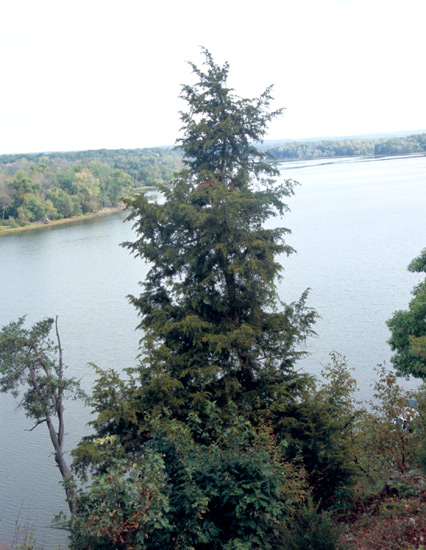
|
|---|
A view of the Elk River from Elk Ridge. Photo by Leonard Miller |

|
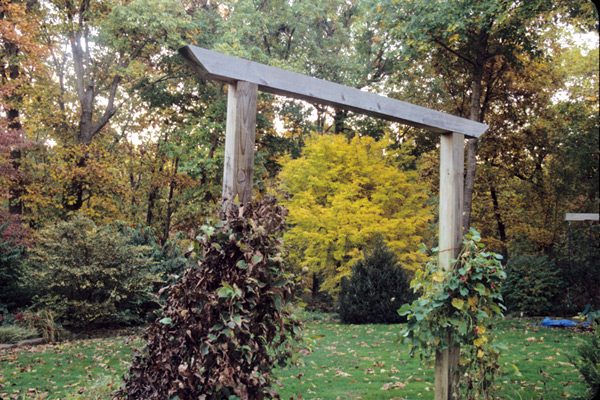
|
|
|---|---|---|
Log Home. Photo by Leonard Miller |
Entrance Garden. Photo by Leonard Miller |
Our property has 425 feet of lake frontage with a beautiful view of the lake and surrounding islands that lie beyond our house. On the cliff is a very old Juniperus viginiana shaped like a giant bonsai 30 feet tall. Our backyard is full of native plants like Aquilegia canadensis (columbine) and Hydrangea arborescens and is not cultivated. The garden is limited to the front yard with three acres of irrigation drawn from the lake. Most of the undesirable trees such as elm, mulberry and black locust were removed because their roots were too aggressive for rhododendrons. Native perennials such as trillium, maiden hair and Christmas fern, Podophyllum (Mayapple), Polygonatum (Solomon's seal), Aureolaria flava (false yellow foxglove), Geranium maculatum (spotted cranesbill) and twenty three other wildflowers grow here at Elkridge. One of my favorites is Thalictrum thalictroides (rue anemone). It blooms over a long period in spring with white to pink daisy-like 1-inch flowers. Wildflowers have increased as a result of increased light and water. Preserving some of these flowers has been difficult while building a garden with two thousand other plants. The most aggressive wildflower, Podophyllum (Mayapple), is quickly covering a large amount of land. Virus in this species has caused some interesting variegate gold foliage.
The goal was to create a garden that looked good in all seasons. My wife loves fall and so I planted a lot of material along the drive that produced good fall color. Berry producing plants were used to give winter color. Since the acreage is primarily shade from large oak trees, I have focused on rhododendrons, hydrangea, pieris and shade loving trees, particularly acers. My favorite rhododendrons from Lendonwood were planted in increased numbers. I planted five plants of 'Anita Gehnrich' and five of 'Nova Zembla', etc. This was different from the garden at Lendonwood, because I planted one of each variety trying to find plants that would live in our climate in Oklahoma. The garden at Elk Ridge is an east-facing slope with three degrees cooler ambient air and at least five degrees cooler soil temperature. This can work against you in winter trying to grow H3 rhododendrons. As new plantings were planned, I have gone back to selecting single cultivars. In six years I have planted 270 rhododendrons and I have lost about twenty. I have been able to reproduce some of the better hybrids of John Thornton that grace the Oriental Garden at Lendonwood. One, which was propagated by Mike Stewart at Dover Nursery, is 'Breezy'. It is a R. hyperythrum X 'Janet Blair' hybrid. This rhododendron was named after my granddaughter who was born on my birthday and lives with her two siblings, Donna and me. It has 3-inch pink flowers, twelve in the truss with a heavy purple stippling, making a more interesting flower than 'Janet Blair'. The leaves have heavy texture and are retained for three years. This rhododendron will be available at the Tulsa convention.

|
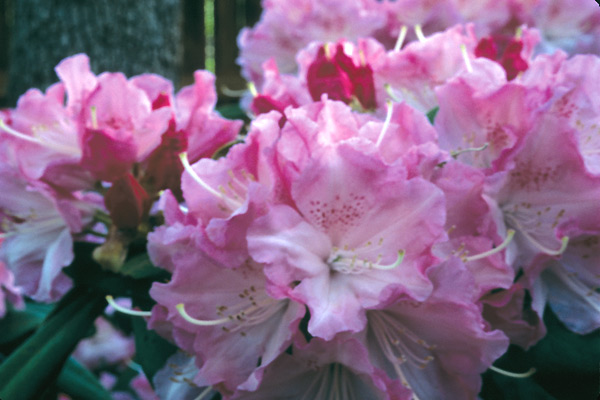
|
|
|---|---|---|
'Breezy'. Photo by Leonard Miller |
Rhododendron 'Peppermint Twist'. Photo by Leonard Miller |
The rhododendron hybrids are the most vigorous and many grow well in this warm climate. I joke by saying this is Ken Janeck's garden, because I have planted a lot of this variety with great results. 'Ken Janeck' is a compact plant with superior foliage. Another rhododendron with that same look is R. smirnowii X R. degronianum ssp. yakushimanum , a cross made by Lancaster recently named 'Freedom Song'* and introduced by Dover Nursery. A garden full of these plants will never look bad after they are finished flowering. Rhododendron williamsianum has given me a lot of heat tolerant hybrids. Rhododendron williamsianum is not very hardy; however, with a hybrid parent they are more tolerant. 'Kristin' is one of the best hybrids of R. williamsianum . Its parentage is R. degronianum 'Koichiro Wada' X Bow Bells Group ('Corona' x R. williamsianum ). All are compact plants with the typical orbicular foliage of R. williamsianum . Hachmann's rhododendrons from Germany have been a bit of disappointment in my climate. I have planted a lot of his hybrids, but his plants fail to hold third or second year foliage and they begin to age very quickly. Two of his best that I grow are 'Hachmann's Polaris' an d 'Barmstedt'. I refuse to pull up 'Hachmann's Charmant' because of its outstanding flower. There are always new hybrids becoming available that I am growing.
Some of the new rhododendron varieties that have lived in Oklahoma are 'Lemon Dream', 'Eruption', 'Jurassic Fantasy'*, 'Voluptuous' and 'Hoopla'. Rhododendron fortunei gives heat tolerance and the Dexter rhododendrons are easy to grow here. Some are slow to flower, but if you want a large rhododendron with large flowers that is hardy, Dexter rhododendrons are a good choice. Most of the Dexters are at Lendonwood, but I have planted 'Charlestown', 'Todmorden' and 'Mrs. W.R. Coe', and 'Gloxineum'. Some of my favorite rhododendrons are 'Ingrid Mehlquist', 'Peppermint Twist', 'Honey Creek'* (available in Tulsa), 'Solidarity', 'Michelle Smith' (best foliage of John Thornton's hybrids available at the Tulsa convention), 'Percy Wiseman', and R. degronianum ssp. yakushimanum .
I am able to grow some species from the subsection Pontica. Both the cold and hot weather are deterrents for most species. In our Zone 6 garden species that have lived are R. hyperythrum , R. degronianum ssp. yakushimanum , R. pseudochrysanthum , and R. makinoi . I am planting a few more from the subsection Pontica such as R. degronianum var. heptamerum (formerly metternichii), R. aberconwayi and R. smirnowii . Hybrids of these species have been very successful here. Most are resistant to soil fungus especially R. hyperythrum and R. degronianum ssp. yakushimanum . All rhododendrons are planted in pine bark and mulched with hardwood tree trimmings. Oak leaves are left on the plants to a depth of four inches. I have planted most of the deciduous azalea species and have been successful with most of these. The R. austrinum hybrids are the strongest growers for our climate. I have planted a number of the Aromi hybrids that are austrinum hybrids.
Each garden faces challenges to grow plants that we love. Pests and animals can reduce the quality of the plants or kill them outright. Our garden is open range to all animals that originally occupied the land plus a few newcomers. The armadillo has been a serious pest. This newcomer to our area that has thrived because a lack of predator is a very destructive animal. It digs up plants looking for worms and grubs and can up-root large rhododendrons destroying the roots. They act like small pigs rototilling the garden. I have built steel wire cages around each of the 250 rhododendrons and some of the rarer trees. I have three Samoyed dogs that can hunt them down and kill them, and they are removing a few from our property. Deer eat my azaleas, so I must cover them with chicken wire.

|
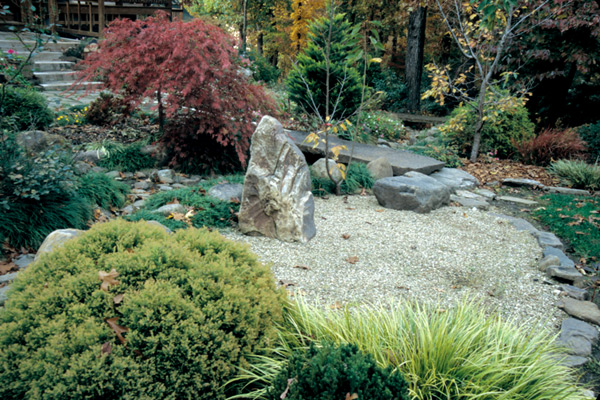
|
|
|---|---|---|
Japanese Garden, tea house. Photo by Leonard Miller |
Zen Garden gravel garden. Photo by Leonard Miller |
Our garden has a lot of natural beauty with large stones covered with lichen and moss. The major hardscape, however, is our Japanese teahouse, "Miyama." I enjoy building and this is my second teahouse. It is half the size of the structure at Lendonwood. The teahouse is situated on a cliff near my home overlooking the lake. It contains a table and a hot tub. The roof is copied from a 200-year-old home in Miyama Cho Japan, and has a Shinto roof. I have visited this small village three times during a student exchange that I developed with the Kyoto prefecture. Inside are gifts from the people of Miyama. Near the teahouse is a granite carved Japanese snow lantern from Japan. On the south are three koi ponds and three 4-foot waterfalls that add a lot of drama to the sitting. The system holds 10,000 gallons of water that are filtered with three large biological filters. The garden around the teahouse is traditional Japanese with evergreen (pine and chamaecyparis) trees, bonsai situated around the pond and a few Japanese maples. Five different types of bamboo aid the atmosphere of the Japanese garden. Other features at Elk Ridge are a 1,600-foot greenhouse with two koi ponds and ten parrots with outside flight cages. Tropical plants are wintered and grown in the ground with temperatures of 60°F nighttime temperatures. The parrot house is used as potting house to grow on young plants. Our home has a koi pond adjacent to the steps to the front porch. The last feature is a tree platform that requires you to walk up a ramp gaining 3 feet, stepping on the platform you are 40 feet in the air.
There are two conifer gardens with over two hundred selections. Near the teahouse is a natural rock garden where the primary plants are conifers. The major plant, however, is a weeping cherry, Prunus 'White Fountain'. A smaller conifer garden is left of the driveway where two plants standout. Weeping conifers Picea abies 'Glauca Pendula' and Picea omorika 'Bruns Pendula' center the planting with a Thuja x 'Green Giant' hedge forming the west boarder. This garden has some perennials that like it dry such as agastache, nepeta and penstemon. Many conifers and perennials do not like the same amounts of water as rhododendrons. Where I have enough sun you will find conifers throughout the garden. Our oldest conifer is a 50-year-old Japanese white pine that was trained in Japan and I have been working on it for ten years.
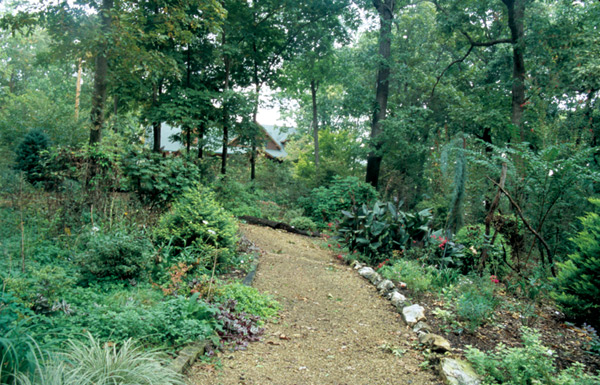
|
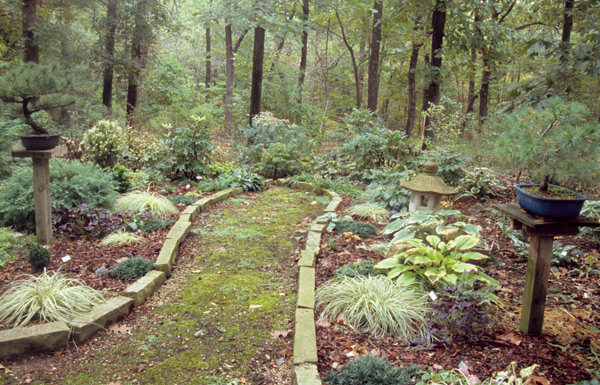
|
|
|---|---|---|
Long blind garden path. Photo by Leonard Miller |
Garden walk. Photo by Leonard Miller |
I have planted over 300 types of perennials, planting 70 of some types. Perennials that thrive here are Pulmonaria , Hosta , Heuchera , Heucherella and Tiarella . Another genus that I am using is Carex . There are 1,500 species found throughout the world, both evergreen and deciduous. Since a few Carex species ( comans , muskingumensis and grayi ) are found naturally here, I have sought Carex that is hardy and attractive. They make excellent companions for rhododendrons, because they prefer shade and above average moisture. The most common, Carex hachijoensis 'Ever Gold', is evergreen and dump-forming, while Carex 'Variegara' is deciduous and rhizomatous. Recently other selections have become available. Along our paths (one-half mile) are planted Carex morrowii 'Gold Fountain' and 'Gold Band', Carex 'Island Brocade' and 'Treasure Island', Carex buchananii and Carex elata 'Bowles Golden'. These planes make excellent borders for rhododendron gardens. At last count there are 800 different plants both woody and herbaceous totaling into the thousands.
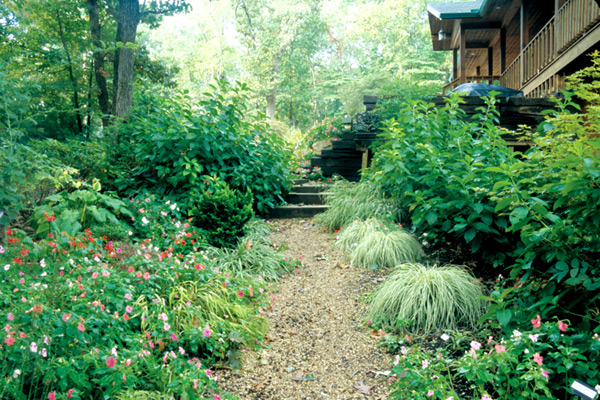
|
|---|
Carex hachijoensis 'Ever Gold'. Photo by Leonard Miller |
What makes a beautiful garden? Some say beauty is in the eye of the beholder, so you must keep your eyes open. For me a garden can be enhanced by having some natural beauty surrounding our efforts. I like a garden that offers year-round interest. It's a place to practice my hobby of plant collecting. Making the garden come together to create beauty is the tricky part. Hardscapes, artifacts and water set the tone and style. It's just fun painting the landscape with plants that we love. Since I live in an oak forest, I choose shade plants and where trees are void I can plant conifers and sun perennials. Elk Ridge is naturally beautiful regardless of my interference. Please come, you might want to stay.
* Name is not registered.
Len Miller, a member of the Ozark Chapter, is Past President of the ARS. He is the founder and past president of the Ozark Chapter.
Elk Ridge will be on the garden tours at the 2008 Annual ARS Convention in Tulsa, Oklahoma.

